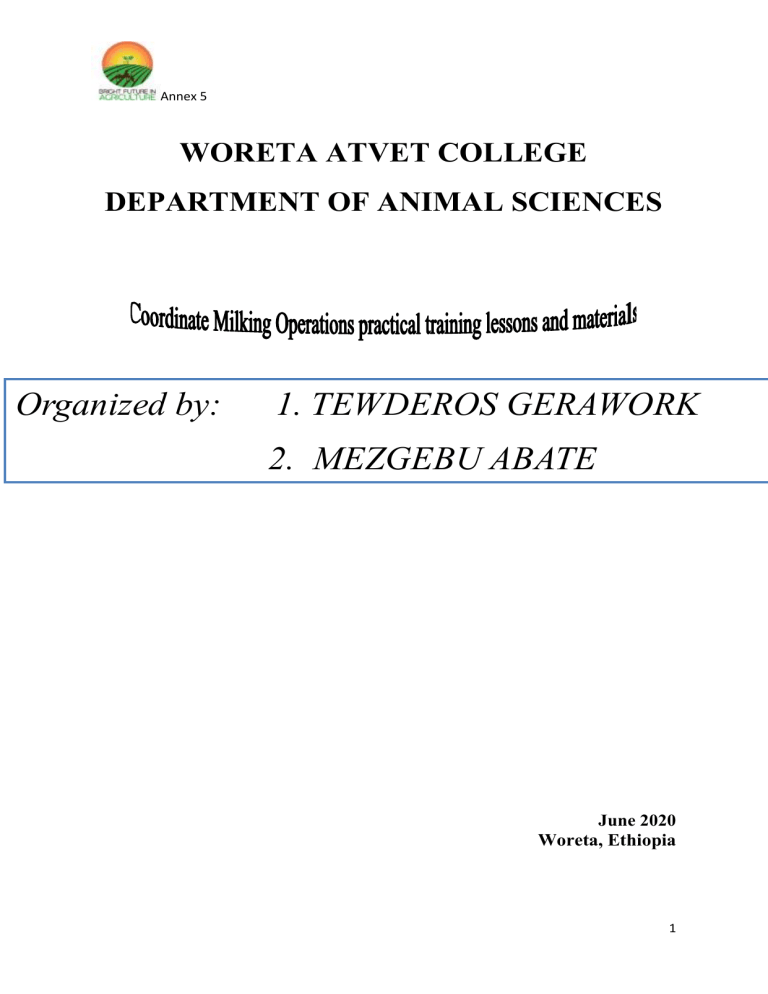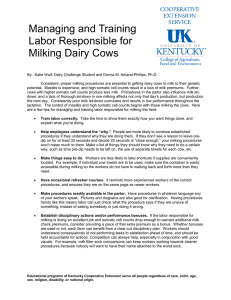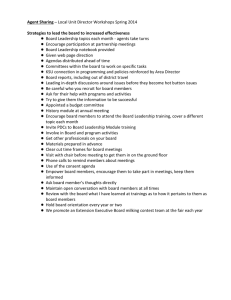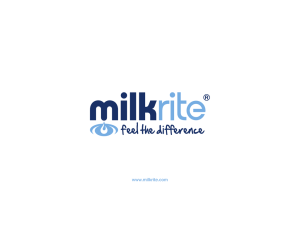
Annex 5 WORETA ATVET COLLEGE DEPARTMENT OF ANIMAL SCIENCES Organized by: 1. TEWDEROS GERAWORK 2. MEZGEBU ABATE June 2020 Woreta, Ethiopia 1 Annex 5 This material is a tool for the teacher to develop practical lessons and Skill Sheets that are in line with the EOS. Practical learning activities are based on 'practical experience' and help students to convert knowledge or information into their personal knowledge that they can apply in different practical situations. Basis is the Ethiopian Occupational Standards (EOS) for Horticulture / Dairy, Level 3 Name of the unit of competence Code of the unit of competence Name of the practical lesson Registration No lesson Coordinate Milking Operations AGR DRP3 07 0311 Hygienic milking procedure AGR DRP3 07 0620 # 01 Purpose of the lesson: To Ensure milking routines do not injure the animals or introduce contaminants into milk To Ensure milking is carried out under hygienic conditions Practical Lesson #1:- Hygienic Milking Procedure Venue Woreta ATVET college Duration Type of trainees Number of students Learning Objectives: 5 day/ 1 hour in every day starting from module delivery Level III Dairy Production students 25-30 The students will be able to: The students will be able to Harvest milk under hygienic condition with minimum stress to animals and maximum yield. Step-by-Step Milking Procedure Step 1. Observation Make sure to identify cows that must be milked last or that are receiving treatment (e.g. those identified with a leg band). Suggested milking order to avoid the spread of mastitis-causing bacteria: 1- Healthy cows. 2- Cows with a questionable health status. (recent purchase, fresh, post-treatment) 3- Cows with chronic mastitis. 4- Cows with an infection caused by a 2 Annex 5 contagious pathogen. Step 2. Fore stripping This step is essential for detecting the early signs of mastitis. It flushes out bacteria from the teat canal and stimulates the milk flow. In tie-stall barns, use a strip cup to have a better chance of detecting the presence of clotty, stringy or watery milk. The strip cup must be cleaned and disinfected after each milking. In the milking parlour, the foremilk can be stripped on the floor, but never into the hand since this can promote further contamination. Fore strip all quarters. If milk is abnormal, examine all quarters and teats by hand to detect early signs of mastitis (redness and warmth) or other lesions. Step 3. Cleaning the teats Use a disinfectant solution and adjust the cleaning time depending on how dirty teats are. To be effective, the re-dip solution must remain in contact with the teats for at least 30 seconds. Only the teats should be wetted and then thoroughly wiped with a dry single service towel. Pay particular attention to teat ends. Alcohol swabs may be used as a test of teat cleanliness. The order of Step 2 and Step 3 can be reversed 3 Annex 5 Step 4. Attaching the milking unit The milking unit should be attached within 60 to 120 seconds after first stimulation. This time allows the milk letdown reflex to occur and maximizes milking performance. Step 5. Adjusting the milking unit Adjust the milking machine to avoid a twist in the hose and to obtain a square position of the four teat cups under the udder. Teat cups must be aligned vertically. The unit alignment should be such that, the claw outlet points between the cow's legs. The claw outlet should point between the cow's front legs for tie stalls and herringbone parlours and between the back legs for parallel parlours. Quickly correct any slipping teat cup. Step 6. End of milking Complete milking should take from 4-6 minutes per cow for most cows. Observe the milk flow carefully or use milk flow indicators to determine the ideal moment for shutting off the milking unit. Avoid over milking. Step 7. Milking unit removal If the claw is removed manually, always shut off the vacuum before attempting to remove the milking unit. When using automatic detachers, make sure that they are properly adjusted. 4 Annex 5 Step 8. Disinfection Once milking is completed, dip the teats fully in a disinfectant solution approved by Health Canada. Teat dip cups must be clean. Discard any unused solution, clean the container thoroughly and prepare fresh solution at each milking. Assignment The student will form a group of five (5) persons and carry out a milking practice situation at a local smallholder dairy farm. The group members will go to the farm- . 1. Observe how the farmers exercise milking 2. Take information on the technical performance milking operation. 3. Prepare an advice for the farmer to improve technical performance of the dairy unit based on the identified root causes 4. Presentation of assessment results and advises to peers The trainer will select nearby smallholder farmers for the fieldwork. 5 Annex 5 Nominal duration (minutes ) 5 Brief Content (Practical activities) Role trainer Didactic working methods Optimum group size Preparing milking items and clean containers for milking. Place of work WATVETC Dairy farm WATVETC Dairy farm 5 Feed the cow it's production ration 5 Restrain animal WATVETC Dairy farm 3 Wash hands with soap and clean water before milking. Dry hands with towel. WATVETC Dairy farm 3 Test for mastitis using a strip cup * Guidance and coaching * Explaining evaluation form *Explaining theory Wash udder with warm clean water + with disinfectant using a clean towel. *Presenting Practical Apply milking jelly prevents cracking examples/ illustrations of teats and eases milking (for hand milking only) Milk quickly and completely by squeezing the teat, do not pull. Milking each cow should take 7–10 minutes at most. WATVETC Dairy farm 2 2 10 Forms of interaction Maximum of five member WATVETC Dairy farm WATVETC Dairy farm WATVETC Dairy farm 6 Annex 5 After milking: Strip the animal getting last drops of milk from udder to avoid incomplete milking (can lead to mastitis). After milking dip the teats in a teat dip WATVETC Dairy farm 2 Recording WATVETC Dairy farm 40 Reflective Assessment and Final Assessment (Practical Demonstration) 2 2 Name: _________________________ Date: ________________ WATVETC Dairy farm WATVETC Dairy farm Time started: ________________Time finished: _____________ Instructions: 1. You are required to perform any of the following: 1.1 Assemble all the necessary materials and equipments for each procedure. 1.2 Perform different activity for each milking operation in front of your teacher 1.3 Clean all the equipment used on the work and Put it in appropriate place at the end of each activity. 2. Request your teacher for evaluation and feedback 7 Annex 5 Lesson Development The lessons are organized based on the standard operating procedure listed under EOS and provokes the students to participate enthusiastically on:• Content or subject matter - content outline • Teaching/learning methods or techniques - lecture - discussion - demonstration, etc • Learning experiences for trainees / learners • Resources and materials – LG, Videos,illustrations,audio-visuals, etc. Skills to be learned in this lesson are: Cleaning and sanitation of milking equipment Hyginic milking procedures Interpret and use written and oral information Implement strict standards of hygiene. Anticipate emergencies and remove hazards in the workplace Necessary materials (Equipment/ tools) Equipment/ tools Number already present to purchase · Milking machine 6 3 3 · The milk bucket 12 3 9 · Two 250 ml sterilised flasks (one for foremilk and one for strippings) 18 6 12 · The strainer (filter) 6 - 6 · The milk cans (transport) 12 2 10 · Measuring cup 6 - 6 · Refragirater 2 - 2 i. Utensils for the harvested milk 8 Annex 5 ii. Utensils for checking the milk · Strip cup 6 1 5 · CMT tester 6 - 6 · Milk chair 6 6 · Restraining materials 6 6 · Cloth or towels to clean the cow 6 6 · Small bucket for water 6 6 iii. Utensils to support the milking process iv. Utensils for cleaning · Water troughs Communal · Brushes 6 · Storage rack 6 6 Quantity already present 13 13 6 to purchase 6 ● Clean towels (one per participant) 30 30 ● Detergents 6 6 ● CMT reagent 6 6 ● Post teat dip chemical 6 6 ● Warm water - - ● Hypochlorite udder disinfectant (80–150 ppm) 6 6 ● Record form 6 6 6 Necessary materials (Consumables) Consumables A group of 6 to 18 milking cows. Disinfectants Prepare the necessary materials / tools / equipment All the aforementioned materials, tools, equipment, PPE, OHS rules, TTLM and operational procedures should be ready before the lesson. Schedule (Outside) Location 9 Annex 5 Industry trainer are responsible in collaboration with course trainer Schedule teacher and / or instructor For every practical lesson course trainer and farm technician are responsible for facilitation Teaching material available on paper (books, readers etc.) Available material Document name / chapter/pages/ Theory lessons see module contents Coordinate Milking Operations learning guide #02 information sheet #01 Practical lessons see module contents Coordinate Milking Operations learning guide #02 operation sheet#01 Practical lesson entirely written out in an Coordinate Milking Operations learning assignment guide #02 The assignment for the students to write a Coordinate Milking Operations learning report guide #02 Indicate how any data collected is recorded Assessment It is important to assess not only the hard competences (practical skills), but also the soft competences to assess also the attitude and personal growth of the students. The assessment can be done by a two level evaluation (final assessment) or a multi-level evaluation (reflective assessment). The reflective assessment and final assessment can be customized for each unit of competences. Hard and Soft Competences of the UC 1 2 3 4 HARD COMPETENCES / SKILLS SOFT COMPETENCES Cleaning and sanitation of milk equipment Maintenance of milk handling and equipment Provide a Low Stress Environment for Cows Check Foremilk and Udder for Mastitis Ability to lead,motivate and delegate Team working Comminication skill Stress management 10 Annex 5 5 6 7 8 9 Wash Teats with an Udder Wash Positive thinking for their task Solution with an Effective Disinfectant Product Dry Teats Completely with an Individual Towel Start the Milking within 120 Seconds after Initiation of Stimulation Dip Teats Immediately After milking with an Effective Disinfectant Product Complite milking cleaning and soring milkink equipments 11



